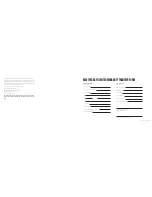
2017 OWNERS MANUAL /
428
of the Owner’s Manual.)
2. Follow the instructions on the brake fluid container. Avoid shaking
the brake fluid container, and pour fluid slowly to minimize air en-
trapment. Let the fluid in the reservoir stand until it is completely
free of air bubbles.
IMPORTANT: Before bleeding the brake lines, bleed the actuator
master cylinder. This is mainly required if a new master cylinder
has been installed, or if the master cylinder was run dry or is low on
fluid. To do so, remove the plastic access cover on the top of the
actuator housing and insert a flat blade screwdriver between the
rear bracket/tab and the fixed tab. The fixed tab is between the
rear bracket/tab and the front (E-brake release) tab. While holding
down the front tab, and using a slow/controlled motion, cycle the
screwdriver fore-aft to pump the master cylinder push rod.
3. Start the bleeding procedure on the brake farthest from the
master cylinder.
4. At the brake assembly, connect a transparent bleeder hose to the
bleed screw fitting on the caliper and submerge the free end into a
container partially filled with brake fluid. Do not reuse this fluid.
5. The first person should stroke the push rod slowly while holding
the safety release bracket down. The second person opens the
bleed screw fitting. Then close the bleed screw fitting BEFORE
the first person SLOWLY releases the push rod. Repeat this pro-
cedure until the fluid expelled from the bleeder hose is free of air
bubbles. Remember to always tighten the bleeder screw before
Brake Lockout
When backing up, the coupler will move back and apply the trailer
brakes. The brakes will apply at different levels depending on how
fast you back up, the type of brakes, the road or surface, and the po-
sition/angle of the trailer. All MasterCraft trailers have an electrical
solenoid control to allow the trailer to back up. This control is wired
to the back-up lights on the tow vehicle, and when the tow vehicle
is put into reverse, this control does not allow the trailer brakes to
apply.
Manual Brake Lockout for the Actuator
If the trailer needs to be moved while in reverse and without elec-
trical connections to operate the reverse lock-out solenoid, the
safety pin can be used to manually keep the coupler from applying
pressure to the master cylinder. Place the pin in the hole at the front
of the actuator housing. Remove the pin IMMEDIATELY after backing
up and replace in the coupler position to lock the coupler.
releasing the push rod. During this procedure, the master cylinder
reservoir fluid level must be maintained at no less than half full.
6. Repeat Steps 4 and 5 for the other brake, as well as the brakes
on the front axle of tandem axle trailers, or the center then finally
the front on triple axle trailers. If installation is on a tandem-axle
or triple-axle trailer, repeat the bleeding procedure on the rear
axle(s) brakes for a second time to assure purging of all air in the
system.
7. Push down on the safety release bracket to ensure that the push
rod is in the released position.
8. After the bleeding is completed, recheck the fluid level in the
master cylinder. Fill the master cylinder reservoir to 1/8” from the
bottom of the threads on the reservoir cap. Do not overfill.
9. As a final check after bleeding is completed, stroke the push
rod and check to be sure the brake system is pressurized. This
is done by attempting to rotate a tire around. It is highly recom-
mended to check the function of the brakes prior to running down
the road. Attempt to back-up the trailer (preferably up and in-
cline) without the wiring harness connected. This should activate
the brakes to verify they are working as expected. If an incline is
not available, and with the wiring harness disconnected, attempt
to back-up the trailer against a wheel chock hard enough to slide
the actuator rearward into the frame and engage the brakes.
Remove the wheel chock and continue to back up to verify the
brakes are engaging.
Failure to do so will cause the loss of brake power when the trailer is
towed.
The reverse lockout option must only be used when moving in
reverse. Immediately remove the pin prior to towing and fully insert
it into the coupler latch.
Manual Bleeding Of Brakes
The following procedure should be performed only by skilled
mechanics. MasterCraft recommends that it be completed only by
an authorized MasterCraft dealer.
Check that all hydraulic fittings are secure. Read and understand
all instructions before starting. Two people are required for manual
bleeding.
1. Remove the master cylinder reservoir cap and fill the reservoir
with brake fluid. Use either DOT 3 (preferred) or DOT 4 automo-
tive brake fluid.
DO NOT USE DOT 5 BRAKE FLUID. DOT 5 FLUID
WILL DAMAGE THE SEALS IN THE ACTUATOR AND CALIPERS
CAUSING FAILURE OF BRAKES THAT COULD LEAD TO INJURY OR
DEATH.
(See recommended brake fluid information in this section
Содержание NXT20 2017
Страница 3: ...2017 OWNERS MANUAL SAFETY KNOWLEDGE ...
Страница 27: ...2017 OWNERS MANUAL 48 2017MODEL FEATURESANDSPECS ...
Страница 40: ...2017 OWNERS MANUAL 74 DASHESAND VIDEOSCREENS ...
Страница 42: ...2017 OWNERS MANUAL 78 XANDXTSERIESINSTRUMENTPANEL 4 3 VIDEOSCREEN XSTARINSTRUMENTPANEL ...
Страница 43: ...2017 OWNERS MANUAL 80 PROSTARINSTRUMENTPANEL NXTSERIESINSTRUMENTPANEL ...
Страница 58: ...2017 OWNERS MANUAL 110 XANDXTSERIES VIDEOSCREEN OPERATIONSHV450 ...
Страница 67: ...2017 OWNERS MANUAL 128 XSTAR VIDEOSCREEN OPERATIONS XSTARINSTRUMENTPANEL ...
Страница 80: ...2017 OWNERS MANUAL 154 PROSTAR VIDEOSCREEN OPERATIONS ...
Страница 97: ...2017 OWNERS MANUAL 188 NXT OPERATIONS ...
Страница 101: ...2017 OWNERS MANUAL 196 NXT20 22 VIDEOSCREEN OPERATIONS ...
Страница 107: ...2017 OWNERS MANUAL 208 BOAT OPERATIONS ...
Страница 158: ...2017 OWNERS MANUAL 310 PREPARATION ...
Страница 172: ...2017 OWNERS MANUAL 338 CAREAND MAINTENANCE ...
Страница 204: ...2017 OWNERS MANUAL 402 TRAILERS ...















































